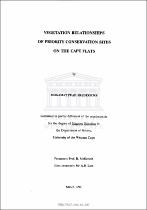| dc.description.abstract | The physical environment of the cape Frats is outlined. The plant communities of twenty-one priority conservation sites are classified. Twenty-five communities, grouped into 15 associations, 8 alliances, 4 orders, 2 subclasses and a single class are defined. This is based entirely on floristic features, following the Braun-Blanquet approach and application of the code of phytosociological Nomenclature. These syntaxa are systematically described with reference to floristic, structural and macroenvironmental features .
The distribution of the communities are indicated on 1:10 000 scale maps of the study sites. The communities are described further in relation to soil chemical and physical variables. The analysis indicates that soil chemical variables are more important in determining vegetation-soil relationships than physical variables. The main variables are soil Ca, pH, p, K, Nd, bulk density, moisture regime, t medium sand and t fine sand.
The "general summary and recommendations" serve as a guideline for interest groups that adequate representatives of each conserved. is intended to so as to ensure community are | en_US |

